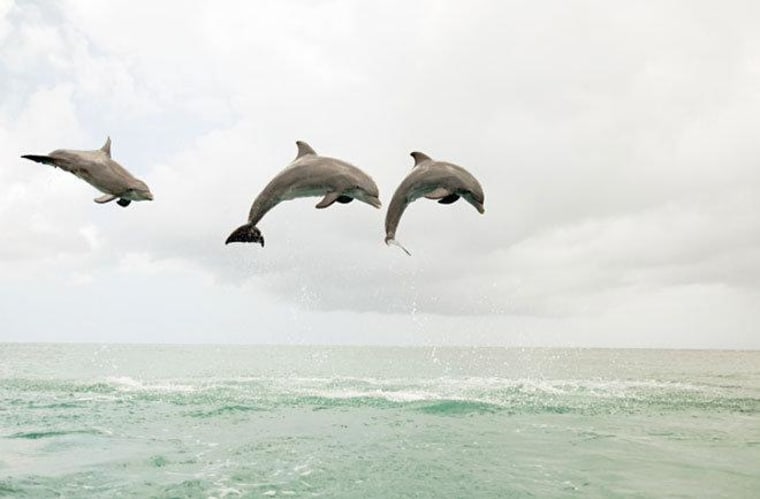Bottlenose dolphins call out the specific names of loved ones when they become separated, a study finds.
Other than humans, the dolphins are the only animals known to do this, according to the study, published in the latest Proceedings of the Royal Society B. The big difference with bottlenose dolphins is that these communications consist of whistles, not words.
Earlier research found that bottlenose dolphins name themselves, with dolphins having a “signature whistle” that encodes other information. It would be somewhat like a human shouting, “Hey everybody! I’m an adult healthy male named George, and I mean you no harm!”
The new finding is that bottlenose dolphins also say the names of certain other dolphins.
“Animals produced copies when they were separated from a close associate and this supports our belief that dolphins copy another animal’s signature whistle when they want to reunite with that specific individual,” lead author Stephanie King of the University of St. Andrews Sea Mammal Research Unit told Discovery News.
King and her colleagues collected acoustic data from wild bottlenose dolphins around Sarasota Bay, Fla., from 1984 to 2009. The researchers also intensely studied four captive adult male dolphins housed at The Seas Aquarium, also in Florida.
The captive males are adults that keepers named Calvin, Khyber, Malabar and Ranier.

These bottlenose dolphins, however, as well as all of the wild ones, developed their own signature whistles that serve as names in interactions with other dolphins.
“A dolphin emits its signature whistle to broadcast its identity and announce its presence, allowing animals to identify one another over large distances and for animals to recognize one another and to join up with each other,” King explained. “Dolphin whistles can be detected up to 20 km away (12.4 miles) depending on water depth and whistle frequency.”
The researchers said dolphins copy the signature whistles of loved ones, such as a mother or close male buddy, when the two are apart. These “names” were never emitted in aggressive or antagonistic situations and were only directed toward loved ones.
The whistle copies also always had a unique variation to them, so the dolphins weren’t merely mimicking each other. The dolphins instead were adding their own “tone of voice” via unique whistling.
While researchers often hesitate to apply the “l word” -- language -- to non-human communications, bottlenose dolphins and possibly other dolphin species clearly have a very complex and sophisticated communication system.
“Interestingly, captive dolphins can learn new signals and refer to objects and it may be that dolphins can use signature whistle copies to label or refer to an individual, which is a skill inherent in human language,” King said.
Heidi Harley, a professor of psychology at New College of Florida, is a leading expert on cognitive processes in dolphins. She agrees with the new paper’s conclusions.
Harley told Discovery News that it can be challenging to study dolphin signature whistles, since it’s difficult to identify which particular dolphin is emitting the sounds, and whether or not the sounds are just mimicked copies.
“This study provides evidence that copies of signature whistles include elements that differ from the whistles of the original whistler, while still maintaining the changes in frequency over time that allow a listener to identify the original whistler,” Harley said. “In addition, that signature whistle copying occurs between close associates, suggesting it is used affiliatively.”
King and her team are now using sound playback experiments to see how wild, free-ranging dolphins respond to hearing a copy of their own signature whistle.
More from Discovery News:
- Photos: Sharks, marine mammals hang in paradise
- Dolphins create 'life raft' for one of their own
- How dolphins stay awake for two weeks
Copyright 2013 Discovery Communications LLC. Reprinted with permission.